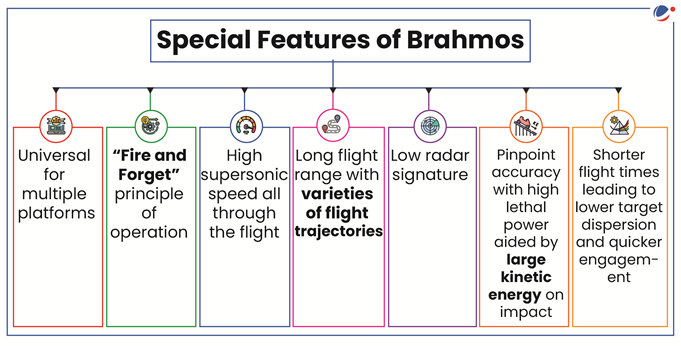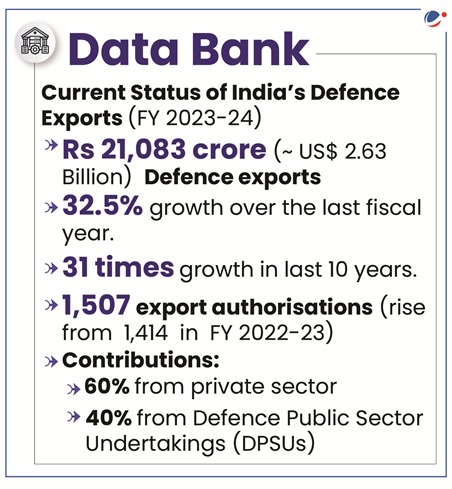Why in the news?
India delivered the first batch of BrahMos to the Philippines.
More on News
- BrahMos Aerospace Private Limited (BAPL) had signed a contract in 2022 for supply of Shore Based Anti-Ship Missile System to Philippines.
- Recent years have witnessed a steady increase in India's defence exports to countries such as Seychelles, the Maldives, Mauritius and Ecuador.
About Brahmos
 |
Reasons for the rise in India's Defence exports

- Financial push:
- Enhanced Foreign Direct Investment (FDI) limit:
- Up to 74% through the Automatic Route for companies seeking new defence industrial licenses.
- Up to 100% through the government route wherever it is likely to result in access to modern technology.
- Venture Capital funds: Agreement to facilitate infusion of Venture Capital into the defence ecosystem through the iDEX Innovators Hub (iIH).
- Financing from Exim Bank for defence exports
- Enhanced Foreign Direct Investment (FDI) limit:
- Encouraging Private Sector Participation: Government has earmarked 25% of the defence research budget for the private sector in 2022-23.
- Initiatives to promote indigenous innovation: E.g.,
- Innovation for Defence Excellence (iDEX) was launched to achieve self-reliance and foster innovation and technology development in defence sector.
- Mission Raksha Gyan Shakti to inculcate and strengthen Intellectual Properties into defence manufacturing.
- Reduced dependence on foreign equipment manufacturer: E.g., 5th Positive Indigenisation List was announced in October 2023, listing Defence Items to be procured from indigenous sources.
- Defence diplomacy: It includes measures like-
- Line of Credit (e.g. to African countries for purchase of weaponry),
- Defence Offset Policy (to leverage capital acquisitions to develop Indian defence industry)
- Marketing products to potential buyers from overseas, etc.
- Infrastructure: Defence Industrial Corridors established in Uttar Pradesh and Tamil Nadu have attracted large scale investments.
Benefits of Rising Defence Exports
- Defence Export as a Strategic Tool:
- Increases diplomatic leverage and scope of strategic partnership with partner nations.
- Moreover, technological dependencies (related to maintenance, repair, spares, components, future upgrades) influence geopolitical stance of nations
- Compatibility between exporting and receiving nations enhances military interoperability through the conduct of military exercises and joint operations.
- Integration with defence value chain by exporting to major countries.
- It also insulates country from supply line disruptions during conflicts such as Russia, Ukraine conflict, Israel-Hamas war etc.
- Increases diplomatic leverage and scope of strategic partnership with partner nations.
- High Value Nature of defence exports: It adds to economic strength through earnings of forex reserves, creation of high-skilled job opportunities, new market opportunities for domestic defence manufacturing etc.
- Other benefits:
- Enhances R&D base in defence through involvement of private players.
- Strengthens national security
- Self-reliance through Indigenization of Defence.
Challenges faced in India's defence export
- Inadequate R&D spending: India is spending is less than 1% in R&D as a part of total defence budget expenditure.
- China and USA spend around 20% and 12% respectively.
- Limited budget: The defense allocation for FY 24-25 is just about 1.9% of the GDP.
- Credibility issues: Indian defence products have less credibility than their counterparts (USA, France, Russia) because of their dependency on imports for advanced weapons.
- As per Stockholm International Peace Research Institute, India has been the world's highest arms importer from 2019 to 2023.
- Inadequate capacity: Massive gap exists with respect to India's manufacturing & export capacity as compared to dominant players.
- Even though India exports military hardware to 85 countries, its share in world export is minuscule.
- India remains outside the top 25 arms exporters in the world.
- Over-reliance on DPSUs: It leads to supply monopolies and creates hurdles in integrating private sector into defence innovation and industrial ecosystem.
- Other issues: Diplomatic issues and competition from other nations; Non-timely delivery of services due to lack of proper infrastructure; Lack of cohesion and coordination between the Indian Armed Forces, the DPSUs, private manufacturers, and the Ministry of Defence etc.
Way Forward
If India to become a dominant force in the global arms market meet its target of US$5 billion in export revenue, following measures can be taken:-
- Use of Export revenue to enhance funding of DPSU R&D budgets or capital expenditure of the government.
- Utilization of Present opportunities in the geopolitics and external factors such as weak and inconsistent performance of China's arms export. (Myanmar's grounding of Chinese jets)
- Establishment of a single point agency responsible for coordination between all stakeholders, executing plans, and meeting the targets for defence exports.
- Quality Assurance and Standardization by adhering to international standards and obtaining certifications thereby enhancing global credibility of Indian defence products.
- MSME Sustainable (ZED) Certification schemes which strives to create an ecosystem of competitive, clean and quality manufacturing, could be leveraged.
- Invest in international marketing and branding to change perceptions about the quality and reliability of its defence products.
- Promote Public-Private Partnerships by greater involvement of the private sector through by offering incentives, facilitating technology transfer, and promoting joint ventures.
- Securing export deals of high value weapons (e.g Pinaka, AKash, Dhruva). by offering of incentives through lines of credit, government-to-government route
Conclusion
Defence exports provide an opportunity to embellish India's growing stature on the global table and improve its strategic leverage with partner nations.



